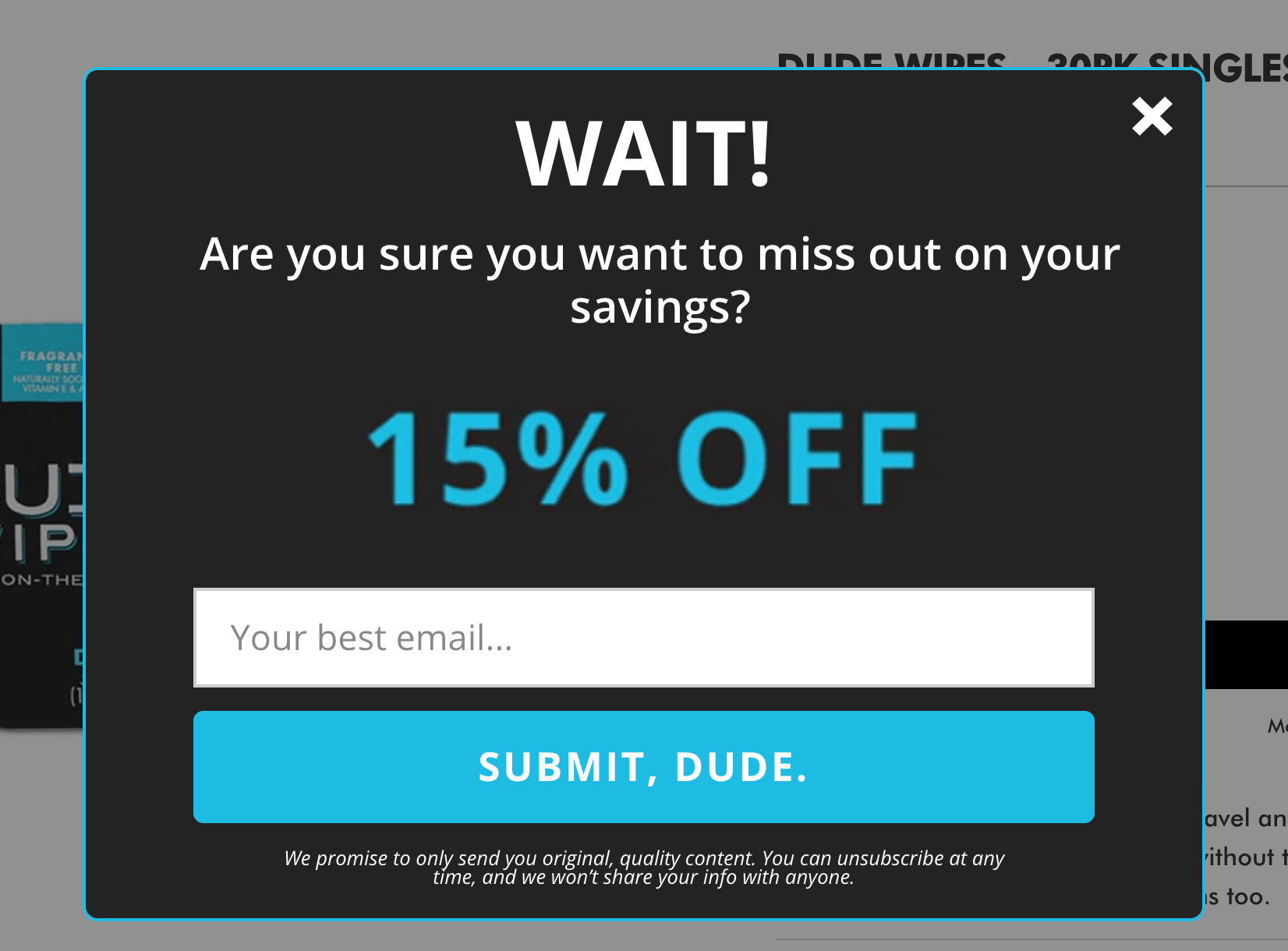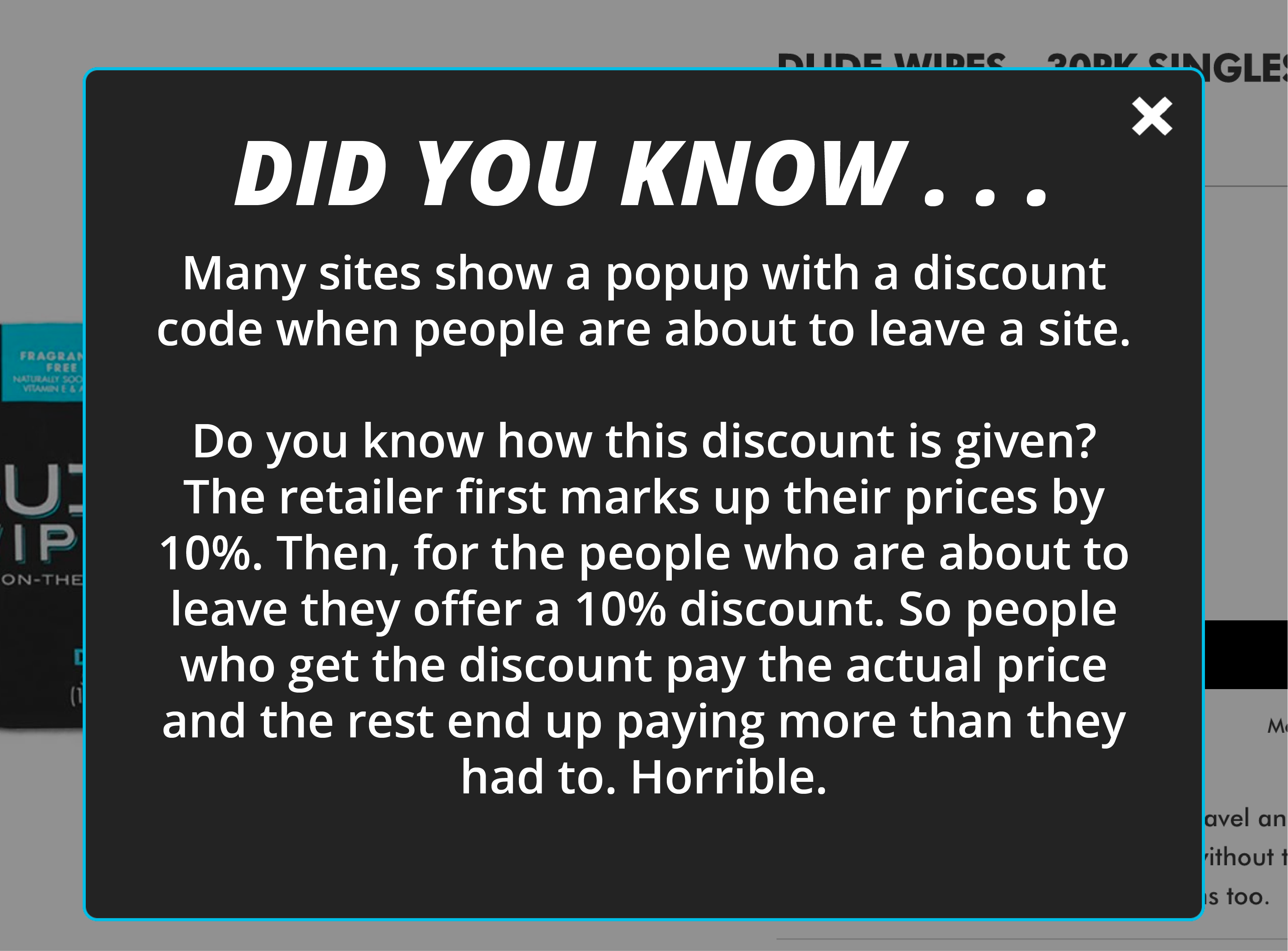Blog
Exit-Intent Discount (A.K.A. Digital Begging)
They’ll come to you with reams of data. It’ll be very convincing. It’ll seem like you have no choice.
But don’t do it.
I’m talking about adding exit-intent discounts to your site. Or, as I call, it: digital begging.
Here is one example but digital begging is a plague spreading all over the ecommerce ecosystem:

We need to aware of the long term consequences of this:
— Is this training shoppers to only buy when incentivized with discounts? Can the addiction be turned off once it takes hold?
— What does this do to our brand perception?
— How does this impact our company culture? Does it take focus away from “build the best product” or “have the best customer service” to “convert at all costs”?
— Can we control this arms race? Surely, our competitors will notice and match us. If they do what’s our next move? Is that really a game worth playing?
So, what is one to do?
You can get creative. For example, you could show an exit-intent popup like this:

Here’s the copy (you can certainly make this more subtle):
DID YOU KNOW . . .
Many sites show a popup with a discount code when people are about to leave a site.
Do you know how this discount is given? The retailer first marks up their prices by 10%. Then, for people about to leave offer a 10% discount. So people who get the discount pay the actual price and the rest end up paying more than they had to. Horrible.




Comments 4
Hi Rishi,
You are right to think about the long term effect of offering discounts. Discounts certainly work in the moment, and that effect is easy to measure, but the long term effect is hard to measure and, consequently, the net effect is also hard to measure.
The exit-intent pop up you discussed in today’s post is a subset within the broad category of efforts to acquire emails. The quid pro quo in all of these efforts , that is, the thing we offer in exchange for the email, is often referred to as a “lead magnet”.
Discounts are one type of lead magnet but there are others and many of these others do no risk cheapening the brand or undermining the perceived value of our offering. Downloadable white papers and other PDFs are one example of such lead magnets. Others include a free evaluation or a customized recommendation.
I believe the ideal lead magnet can also be the hardest to come up with. But the ideal lead magnet obtains the prospects email in exchange for a benefit that only can be delivered using the prospect’s email address. In such cases, we do not obtain the email address as a quid pro quo but because it is highly impractical to deliver the benefit without the email address. One example of such a lead magnet is the used card website that says “Would you like to receive an email about price drops on this car?” This is brilliant because it is a high-value lead magnet and the benefit to be delivered cannot simply be given now – it can only be given in the future and at that point the used car website needs a way to communicate the new price to you. It also is excellent because it is directly on-point with the prospect’s interests and very naturally sets up a conversation about buying the product (in this example, a car).
Thanks for another thought-provoking post Rishi. Have a great week.
All my best,
Jerry
ReplyRishi Rawat
Jerry: One example of such a lead magnet is the used card website that says “Would you like to receive an email about price drops on this car?” This is brilliant because it is a high-value lead magnet and the benefit to be delivered cannot simply be given now – it can only be given in the future and at that point the used car website needs a way to communicate the new price to you. It also is excellent because it is directly on-point with the prospect’s interests and very naturally sets up a conversation about buying the product (in this example, a car).
ReplyRishi: Yes! I love that example. Thanks for adding your valuable input. Have a great week.
Might not be a true statement! I’d prefer something like highlighting benefits of shopping on the site.
ReplyRishi Rawat
Why do you think it might not be a true statement? I’d love to know.
The wording on my popup message wasn’t well-formatted. But the point is that retailers know upfront if they’ll be giving a discount on an item. It’s all preplanned. When Menards has an 11% sale their marketing team knew this 6 months in advance. When a retailer introduces an item to the store they set the price based on their future discounting strategy. Let’s say Menards launches their 11% storewide sale on January 16th and I visited the store on January 15th I would be paying extra for an item I could have had for 11% less the next day. Menards knows this. I paid a premium for an item Menards knew could be priced 11% lower.
That’s capitalism fair and square. Nothing wrong or illegal about that.
But if a retailer doesn’t want to play these discount games they should craft a story around it. Our popup message was an attempt at that story. But it’s clear it wasn’t polished enough. If I ran this as an A/B test I would refine the message and tone it down.
Thanks for the comment, Sarah!
Reply